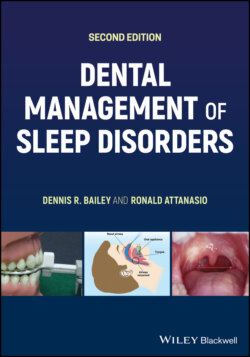Читать книгу Dental Management of Sleep Disorders - Ronald Attanasio - Страница 65
Basics of Airway Dynamics
ОглавлениеThere are two basic principles of airway dynamics that come into play, the Venturi effect and the Bernoulli principle. The Venturi effect says that if the diameter of a tube is decreased, in this case the airway, then for a given volume of fluid to pass through the tube the velocity has to increase. A classic example or comparison is the garden hose. This basic concept relates to snoring, as the airway caliber is narrowed, soft tissues within the airway may vibrate. The Bernoulli principle states that as fluid flows through a tube and with an increase in the flow of that substance, there is an increase in negative pressure at the periphery. This then contributes to an increased potential for airway collapse. An example is a paper straw; as more force is applied the straw is more likely to collapse.
Another concept is that of the variable resistor. In this situation, as the rate of flow increases so does the resistance to that flow. However, the classic explanation that involves airway collapse related to flow is the starling resistor concept. In this situation, a collapsible tube is positioned between two rigid structures. In this case, the collapsible tube is the airway and is between the craniofacial structures, nasal airway, and the trachea. When the airflow increases and the pressure outside the tube is greater than the pressure inside the tube, this leads to collapse. In the awake state, the airway is not subject to these fluctuations in pressure and the airway remains open. However, during sleep when the airway relaxes and negative pressure increases the transmural forces that support the airway are not capable of resisting the negative pressure and this leads to airway restriction or obstruction. During respiration, the flow through the tube (airway) may be unimpeded, causes flutter, or becomes blocked depending on the variation in pressure. This correlates with normal breathing, snoring, and obstruction associated with apnea [17].
Another consideration is the critical closing pressure, known as Pcrit. The Pcrit is related to the ability of the upper airway muscles to resist collapse. Being associated with the collapsibility of the airway this may be related to upper airway anatomy [18]. One study found that certain cephalometric measurements were predictive of the Pcrit. In particular, the airway length and the relationship of the hyoid to the mandibular plane are relevant.
The concept of loop gain (LG) has become a known factor related to the airway and to successful management of SRBD, especially with oral appliance therapy (OAT). LG is related to an unstable ventilatory response to a disturbance in respiration [19]. When the LG is low, a more desirable situation, then the response to a respiratory disturbance more easily returns to a stable pattern [20]. If the LG is higher, then the response is greater and hence unstable. This results in more difficulty managing the respiratory disturbance. A lower LG is favorable to successful OAT.
